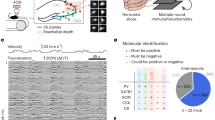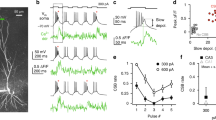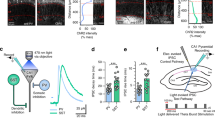Abstract
In hippocampal slices, synchronous CA3 network activity induced persistent strengthening of active positive-feedback synapses. This altered network operation by increasing probability of future synchronous network activation. Long-term depression of synaptic strength induced by partial blockade of NMDA receptors during synchronous network activity reversed changes in probability of spontaneous network activation. These results suggest that specific network activity patterns selectively alter strength of active synapses. Stable, reversible alterations in network activity can also be effected by corresponding alterations in synaptic strength. These findings confirm the Hebb memory model at the neural-network level and suggest new therapies for pathological patterns of network activity in epilepsy.
This is a preview of subscription content, access via your institution
Access options
Subscribe to this journal
Receive 12 print issues and online access
$209.00 per year
only $17.42 per issue
Buy this article
- Purchase on Springer Link
- Instant access to full article PDF
Prices may be subject to local taxes which are calculated during checkout







Similar content being viewed by others
References
Hebb, D. O. The Organization Of Behavior (Wiley, New York, 1949 ).
Brown, T. H., Kairiss, E. W. & Keenan, C. L. Hebbian synapses: biophysical mechanisms and algorithms. Annu. Rev. Neurosci. 13, 475– 511 (1990).
Bliss, T. V. & Collingridge, G. L. A synaptic model of memory: long-term potentiation in the hippocampus. Nature 361 , 31–39 (1993).
Churchland, P. S. & Sejnowski, T. J. in The Computational Brain (eds. Sejnowski, T. J. & Poggio, T.) Vol. 1, 239– 339 (MIT Press, Cambridge, Massachusetts, 1992).
Hopfield, J. J. & Tank, D. W. Computing with neural circuits: A model. Science 233, 625 –633 (1986).
Zhang, K., Ginzburg, I., McNaughton, B. L. & Sejnowski, T. J. Interpreting neuronal population activity by reconstruction: unified framework with application to hippocampal place cells. J. Neurophysiol. 79, 1017–1044 (1998).
MacVicar, B. A. & Dudek, F. E. Local circuit interactions in rat hippocampus: interactions between pyramidal cells. Brain Res. 242, 341–344 (1982).
Debanne, D., Gähwiler, B. H. & Thompson, S. M. Long-term synaptic plasticity between pairs of individual CA3 pyramidal cells in rat hipppocampal slice cultures. J. Physiol. (Lond.) 507.1, 237–247 ( 1998).
Selig, D. K., Nicoll, R. A. & Malenka, R. C. Hippocampal long-term potentiation preserves the fidelity of postsynaptic responses to presynaptic bursts. J. Neurosci. 19, 1236–1246 ( 1999).
Fisahn, A., Pike, F. G., Buhle, E. H. & Paulsen, O. Cholinergic induction of network oscillations at 40 Hz in the hippocampus in vitro. Nature 394, 186– 189 (1998).
Traub, R. D. & Miles, R. in Neuronal Networks Of The Hippocampus Ch. 6 (Cambridge Univ. Press, Cambridge, UK, 1991).
Staley, K. J., Longacher, M., Bains, J. S. & Yee, A. Presynaptic modulation of CA3 network activity. Nat. Neurosci. 1, 201–209 (1998).
Buzsáki, G. Hippocampal sharp waves: their origin and significance. Brain Res. 398, 242–252 ( 1986).
Traub, R. D. & Wong, R. K. S. Cellular mechanism of neuronal synchronization in epilepsy. Science 216, 745–747 (1982).
Jefferys, J. G. Mechanisms and experimental models of seizure generation. Curr. Opin. Neurol. 11, 123–127 (1998).
O'Donovan, M. J. & Chub, N. Population behaviour and self-organization in the genesis of spontaneous rhythmic activity by developing spinal networks. Semin. Cell Dev. Biol. 8, 21–28 (1997).
Chamberlin, N. D., Traub, R. D. & Dingledine, R. Role of EPSPs in initiation of spontaneous synchronized burst firing in rat hippocampal neurons bathed in high potassium. J. Neurophysiol. 64, 1000–1008 (1990).
Senn, W., Segev, I. & Tsodyks, M. Reading neuronal synchrony with depressing synapses. Neural Comput. 10, 815– 819 (1998).
Suppes, T., Kriegstein, A. R. & Prince, D. A. The influence of dopamine on epileptiform burst activity in hippocampal pyramidal neurons. Brain Res. 326, 273–280 (1985).
Whittington, M. A., Traub, R. D., Faulkner, H. J., Stanford, I. M. & Jefferys, J. G. Recurrent excitatory postsynaptic potentials induced by synchronized fast cortical oscillations. Proc. Natl. Acad. Sci. USA. 94, 12198– 12203 (1997).
Maeda, E., Kuroda, Y., Robinson, H. P. & Kawana, A. Modification of parallel activity elicited by propagating bursts in developing networks of rat cortical neurons. Eur. J. Neurosci. 10, 488–496 (1998).
Ben-Ari, Y. & Gho, M. Long-lasting modification of the synaptic properties of rat CA3 hippocampal neurones induced by kainic acid. J. Physiol. (Lond.) 404, 365–384 (1988).
Schneiderman, J. H., Sterling, C. A. & Luo, R. Hippocampal plasticity following epileptiform bursting produced by GABAA antagonists. Neuroscience 59, 2259–273 (1994).
Huerta, P. T. & Lisman, J. E. Heightened synaptic plasticity of hippocampal CA1 neurons during a cholinergically induced rhythmic state. Nature 364, 723–725 (1993).
Rutecki, P. A., Lebeda, F. J. & Johnston, D. Epileptiform activity induced by changes in extracellular potassium in hippocampus. J. Neurophysiol. 54, 1363–1374 (1985).
Scanziani, M., Debanne, D., Muller, M., Gähwiler, B. H. & Thompson, S. M. Role of excitatory amino acid and GABAB receptors in generation of epileptiform activity in disinhibited hippocampal slice cultures. Neuroscience 61, 823– 832 (1994).
Xiang, Z. & Brown, T. H. Complex synaptic current waveforms evoked in hippocampal pyramidal neurons by extracellular stimulation of dentate gyrus. J. Neurophysiol. 79, 2475– 2484 (1998).
Bowery, N. G., Hill, D. R., Hudson, A. L. & Doble, A. (–) Baclofen decreases neurotransmitter release in the mammalian CNS by an action at a novel GABA receptor. Nature 283, 92–94 (1980).
Scanziani, M., Capogna, M., Gähwiler, B. H. & Thompson, S. M. Presynaptic inhibition of miniature excitatory synaptic currents by baclofen and adenosine in the hippocampus. Neuron 9, 919–927 (1992).
Smith, K. L. & Swann, J. W. Long-term depression of perforant path excitatory postsynaptic potentials following synchronous network bursting in area CA3 of immature hippocampus. Neuroscience 89 , 625–630 (1999).
Bear, M. F. & Malenka, R. C. Synaptic plasticity: LTP and LTD. Curr. Opin. Neurobiol. 4, 389– 399 (1994).
Fedirchuk, B. et al. Spontaneous network activity transiently depresses synaptic transmission in the embryonic chick spinal cord. J. Neurosci. 19, 2102–2112 (1999).
Cummings, J. A., Mulkey, R. M., Nicoll, R. A. & Malenka, R. C. Ca2+ signalling requirements for long-term depression in the hippocampus. Neuron 16, 825– 833 (1996).
Dunwiddie, T. & Lynch, G. Long-term potentiation and depression of synaptic responses in the rat hippocampus: localization and frequency dependency. J. Physiol. (Lond.) 276, 353– 367 (1978).
Miller, K. D. Synaptic economics: competition and cooperation in synaptic plasticity. Neuron 17, 371–374 ( 1996).
Abbott, L. F., Varela, J. A., Sen, K. & Nelson, S. B. Synaptic depression and cortical gain control Science 275, 220 –224 (1997).
Tsodyks, M. & Markram, H. The neural code between neocortical pyramidal cells depends on neurotransmitter release probability. Proc. Natl. Acad. Sci. USA 94, 719– 723 (1997).
Petersen, C. C., Malenka, R. C., Nicoll, R. A. & Hopfield, J. J. All-or-none potentiation at CA3–CA1 synapses. Proc. Natl. Acad. Sci. USA 95, 4732–4737 (1998).
Abraham, W. C. & Bear, M. F. Metaplasticity: the plasticity of synaptic plasticity. Trends Neurosci. 19, 126–130 (1996).
Dobrunz, L. E. Long-term potentiation and the computational synapse. Proc. Natl. Acad. Sci. USA 95, 4086–4088 (1998).
Huang, Y. Y., Colino, A., Selig, D. K. & Malenka, R. C. The influence of prior synaptic activity on the induction of long-term potentiation. Science 255, 730–733 ( 1992).
Buzsáki, G. Two-stage model of memory trace formation: a role for "noisy" brain states. Neuroscience 31, 551–570 (1989).
Griffith, W. H. & Taylor, L. Sodium valproate decreases synaptic potentiation and epileptiform activity in the hippocampus. Brain Res. 474, 155–164 (1988).
Stasheff, S. F., Anderson, W. W., Clark, S. & Wilson, W. A. NMDA antagonists differentiate in epileptogenesis from seizure expression in an in vitro model. Science 24, 648– 651 (1989).
Rafiq, A., Zhang, Y. F., DeLorenzo, R. J. & Coulter, D. A. Long-duration self-sustained epileptiform activity in the hippocampal-parahippocampal slice: a model of status epilepticus. J. Neurophysiol. 74, 2028–2042 (1995).
Claiborne, B. J., Xiang, Z. & Brown, T. H. Hippocampal circuitry complicates analysis of long-term potentiation in mossy fiber synapses. Hippocampus 3 , 115–122 (1993).
Willams, S. H. & Johnston, D. Kinetic properties of two anatomically distinct excitatory synapses in hippocampal CA3 pyramidal neurons. J. Neurophysiol. 66, 1010– 1020 (1991).
Debanne, D., Guerineau, N. C., Gähwiler, B. H. & Thompson, S. M. Physiology and pharmacology of unitary synaptic connections between pairs of cells in areas CA3 and CA1 of rat hippocampal slice cultures. J. Neurophysiol. 73, 1282–1294 (1995).
Acknowledgements
We thank members of the Staley and Dunwiddie labs for comments on the manuscript. J.S.B. is supported by an International Human Frontier Science Program Fellowship. This work was supported by grants from the National Institutes of Health, The Epilepsy Foundation of America and The Campbell Pediatric Epilepsy Fund.
Author information
Authors and Affiliations
Corresponding author
Rights and permissions
About this article
Cite this article
Bains, J., Longacher, J. & Staley, K. Reciprocal interactions between CA3 network activity and strength of recurrent collateral synapses. Nat Neurosci 2, 720–726 (1999). https://doi.org/10.1038/11184
Received:
Accepted:
Issue Date:
DOI: https://doi.org/10.1038/11184
This article is cited by
-
NMDA-receptor-dependent plasticity in the bed nucleus of the stria terminalis triggers long-term anxiolysis
Nature Communications (2017)
-
Alterations in the Intrinsic Burst Activity of Purkinje Neurons in Offspring Maternally Exposed to the CB1 Cannabinoid Agonist WIN 55212-2
The Journal of Membrane Biology (2014)
-
Homeostatic regulation of spontaneous and evoked synaptic transmission in two steps
Molecular Brain (2013)
-
Bidirectional NMDA receptor plasticity controls CA3 output and heterosynaptic metaplasticity
Nature Neuroscience (2013)
-
Spatiotemporal dynamics of high-K+-induced epileptiform discharges in hippocampal slice and the effects of valproate
Neuroscience Bulletin (2013)



